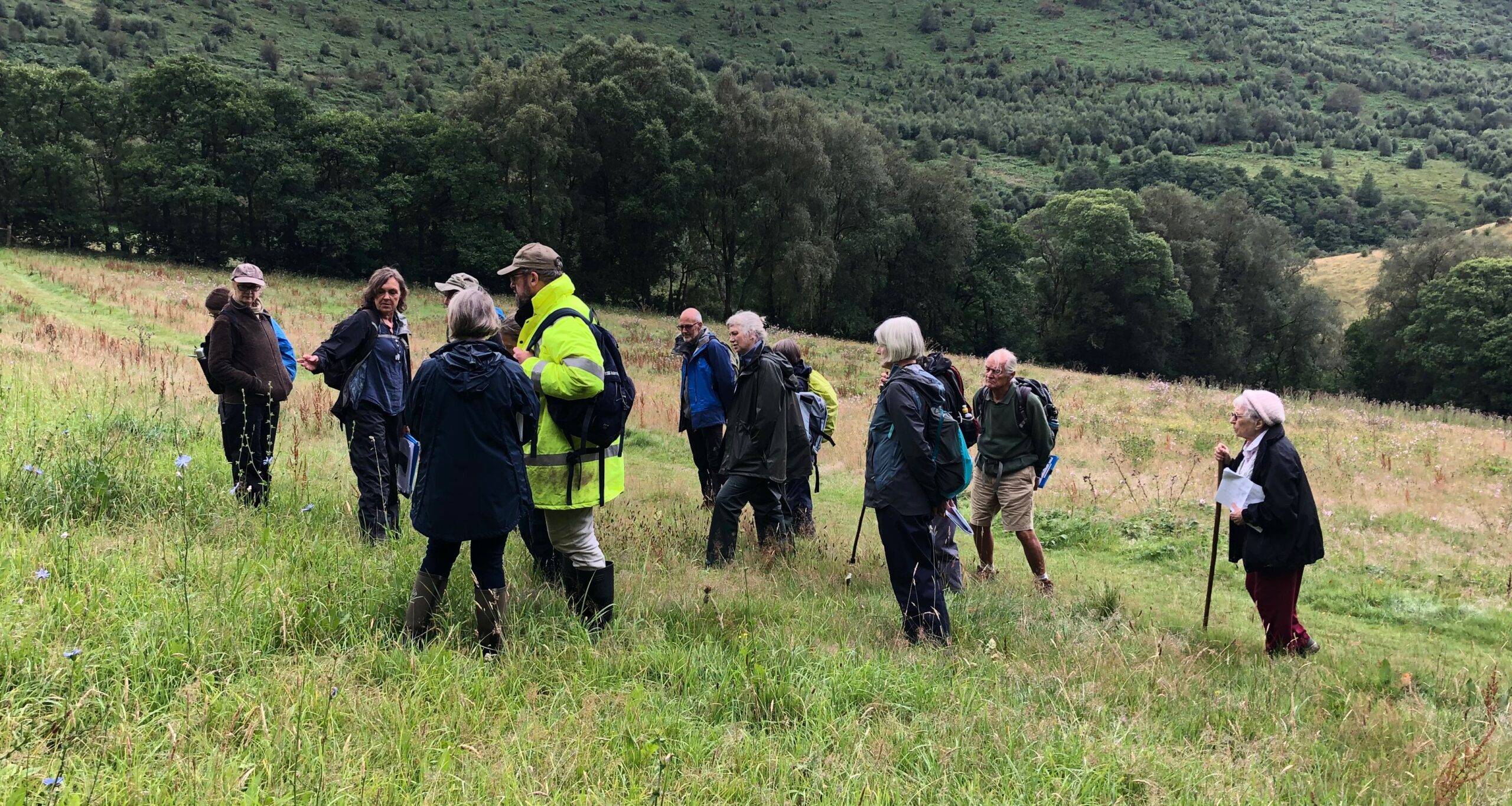Gilfach and Abbey Cwmhir home grange
The weekend of 14 and 15 August was dedicated to looking at the botany of the old farmstead, Cwmffwrn, in the home grange to Abbey Cwmhir. However as an introduction to both upland and species of traditional farms, Saturday was spent at the Gilfach reserve, an old farm owned by Radnorshire Wildlife Trust. Along with the unimproved traditional pastures and meadows, we looked at species of riverside, woodland edge, bog and heathland. Highlights were swathes of the beautiful Betonica officinalis Betony and the facinating Narthecium ossifragum Bog Asphodel and Succisa pratensis. Devil’s-bit Scabious. We also examined, for example, the features which differentiate the three heaths: Calluna vulgaris Heather, Erica cinerea Bell Heather and Erica tetralix Cross-leaved Heath.
On Sunday following an introductory talk on archaeobotany, we walked through bog, acid grassland, willow carr and bracken to the various sites where medieval farm buildings once stood. The moorland plants had long since taken over, but it was interesting to see what now grew there: various sedges Carex species, Nardus stricta Heath Grass, Molinea caerulea Purple moorgrass, Juncus squarrosus, Heath Rush and Pedicularis sylvatica Lousewort. In wetter places we found the lovely Achillea ptarmica Sneezewort, Mentha aquatica Water Mint and Potamogeton polygonifolius Bog Pondweed.
Towards the end of the walk, we explored the remains of an old farmhouse with some remaining walls. Ferns love such sites and many encouraged by the old lime mortar. We found Polypody vulgare Common Polypody, Asplenium trichomanes Maidenhair Spleenwort, Dryopteris dilatata Broad Buckler-fern and Dryopteris filix-mas Male Fern which are all found commonly growing on and around old buildings. The ruderal, Chamerion angustifolium Rose-bay Willowherb was growing in abundance along with Ribes uva Gooseberry, Urtica dioica Nettle, the latter two species long outliving former occupants of such buildings.
Useful books:
Wildflowers of Britain and Ireland: Marjorie Blamey, Richard Fitter and Alastair Fitter
The Wildflower Key (new revised edition): Francis Rose and Claire O’Reillly
Wildflower Guide 2nd edition: Collins
Britain’s Ferns: James Merryweather
Grasses, Sedges, Rushes and Ferns of the British Isles and NW Europe: Francis Rose
Ways to increase your field botanical identification skills:
The Field Studies Council run excellent natural history courses at for example: Preston Montford, Shrewsbury; Rhyd-y-creuau, Betws-y-coed; Dale Fort, Pembrokeshire, plus 10 other centres around the UK: www.field-studies-council.org
Radnorshire Local Recording Group, contact: Liz Dean, County Recorder to find out about botanical outings close to you: erd@btconnect.com
Shropshire Botanical Society organise around 6 field outings a year throughout Shropshire: www.shropshirebotany.org.uk
Plantlife International, run events and campaigns around the UK to encourage people to record: www.plantlife.org.uk
Flora Locale run plant ID and habitat management courses: floralocale.org
Record your observations on LERC Wales app https://www.lercwales.org.uk/app.php
Information provided for this Field School was:
Botany Field School Handbook 2021 Final
Plant Identification handout FINAL
Fiona Gomersall


I was listening to a talk by Darylle Hardy from Radnorshire Wildlife Trust yesterday and she was talking about the value of using the LERC app to record botany sightings. I’ve been a bit nervous of using it in case I make a mistake in the identification, but I’ve learned that the PlantNet app is surprisingly good at identification and that the identification is checked by those running LERC before it going ‘on the record’.
Really interesting two days with a huge amount of information provided by our very knowledgeable botanist guide, Fiona. Great to learn more about our local flora.